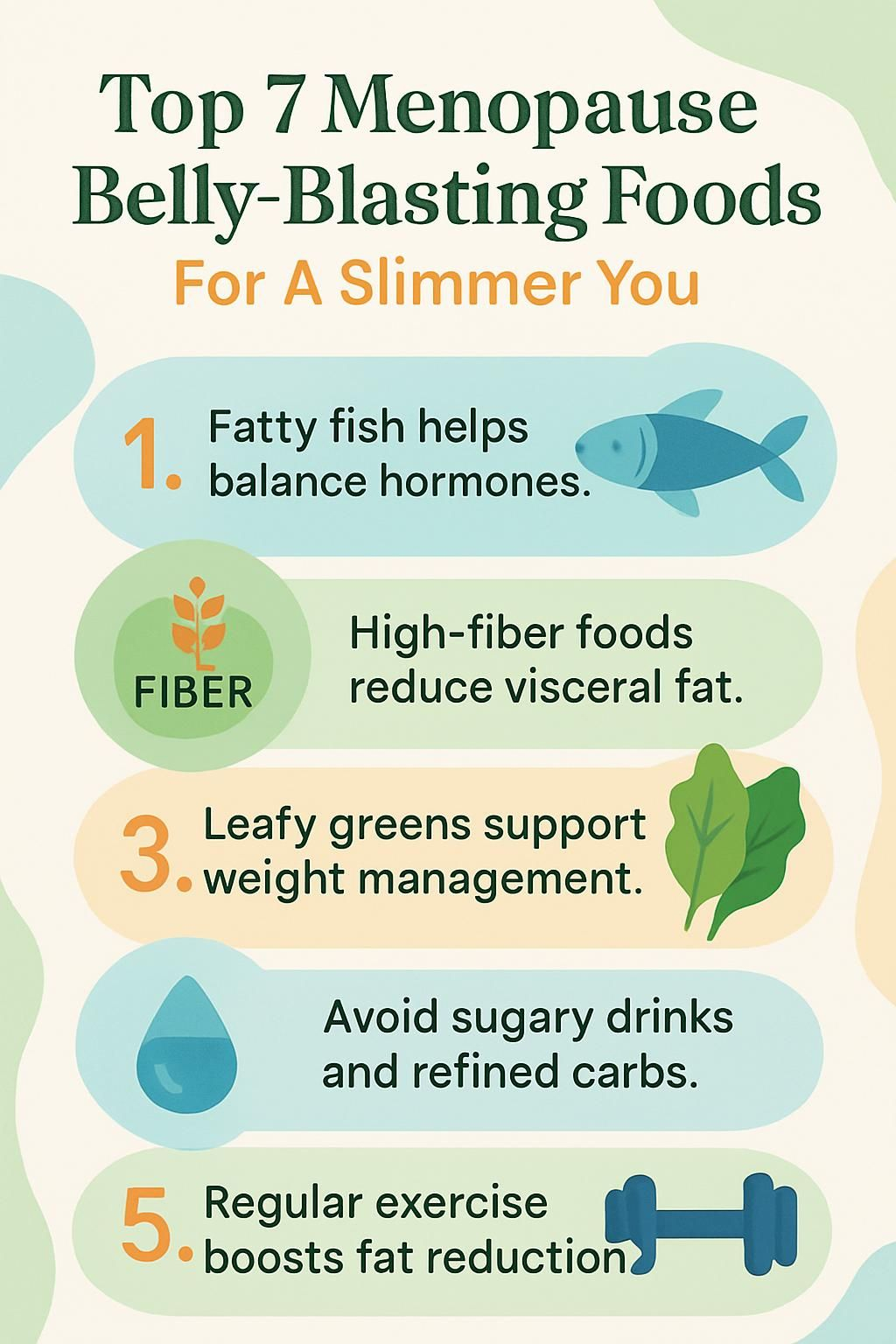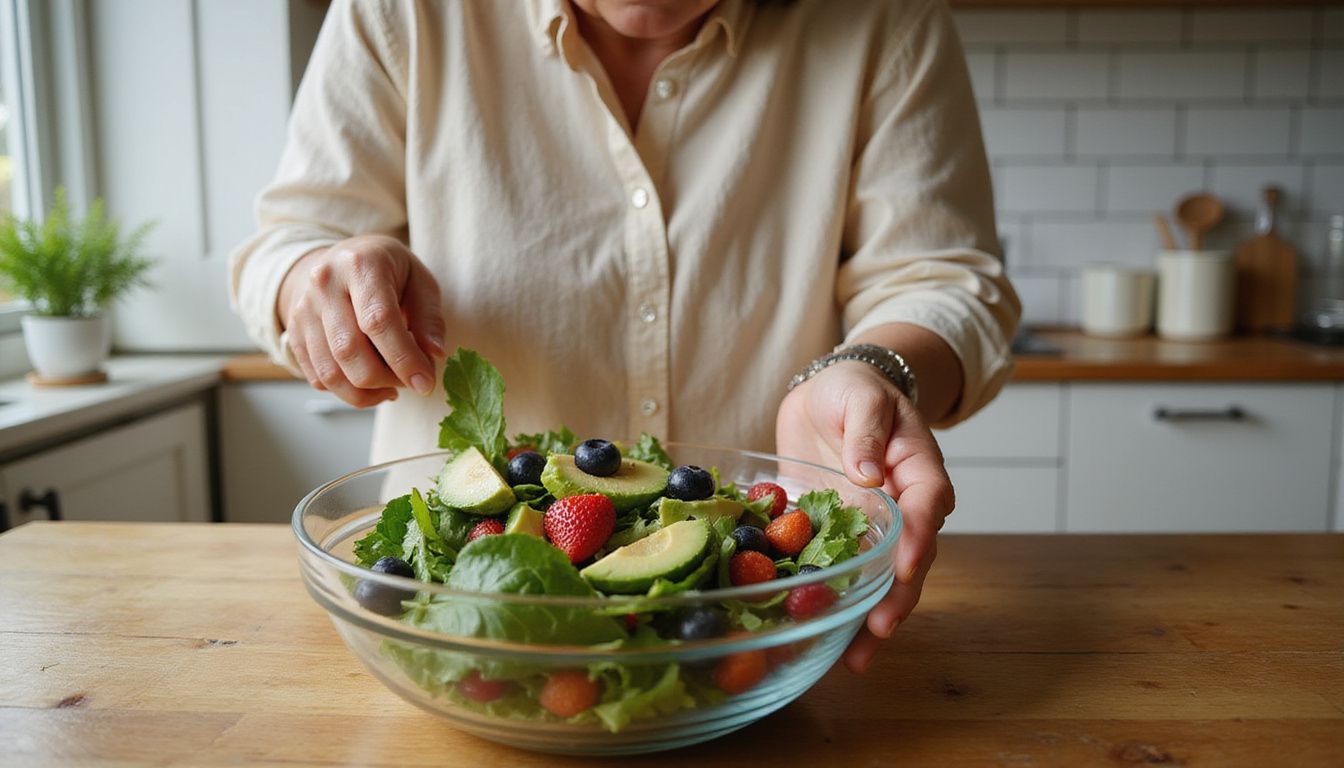Top 7 Menopause Belly-Blasting Foods For A Slimmer You
Our Nutrition Assistant AI Suite will transform your body. You will lose fat, get toned, and build muscle. Gain confidence and optimal health.
Many women notice extra belly fat during menopause and want safe, simple ways to manage weight. Hormone shifts and a slower metabolism can push fat to the midsection and raise the risk of heart disease and diabetes. A focused menopause diet can help you lower belly fat while supporting energy, mood, and long-term health.
This guide highlights the best foods for a flatter waist, plus easy tips to get started today. The information is educational and not a substitute for medical advice.
Key Takeaways
- Fatty fish, leafy greens, whole grains, legumes, berries, nuts and seeds, and probiotic-rich foods support weight loss and hormone balance in menopause.
- High-fiber, anti-inflammatory foods help lower visceral fat, reduce menopause belly, and improve risks tied to heart disease and diabetes.
- Hormone changes and loss of muscle slow metabolism, so nutrient-dense, low-glycemic meals and portion control are essential.
- Limiting processed foods, refined carbs, sugary drinks, and alcohol helps prevent blood sugar spikes and extra belly fat.
- Regular aerobic exercise, strength training, quality sleep, and stress control amplify the benefits of a healthy diet.

How Menopause Causes Belly Fat Gain

Hormonal shifts during menopause often lead to weight gain, especially around the abdomen. Changes in metabolism and body composition make it easier for fat to build up with age.
How do hormonal changes affect fat storage during menopause?
Estrogen falls during the transition to menopause. Lower estrogen signals your body to store more fat in the belly instead of the hips and thighs. Studies show many women experience a shift in fat distribution, with more weight moving to the midsection.
Falling progesterone may also contribute to increases in visceral fat, the deeper fat around organs. You might see weight gain even if eating and activity stay the same. Hormone therapy can help hot flashes and sleep, but it is not a weight-loss treatment.
Why does metabolism slow down during menopause?
Loss of muscle plays a major role. Women lose about 1 percent of muscle each year after age 30. This decline can speed up during menopause due to lower activity and hormone changes.
Less muscle means your body burns fewer calories at rest, which makes belly fat easier to gain and harder to lose. Poor sleep, common at this stage, can slow calorie burn as well. “Quality sleep helps preserve your muscle mass and keeps your metabolism steady.” Aging also changes where fat is stored, with more held in the abdomen as muscle decreases.
Taken together, these shifts make weight management in midlife more challenging.
Challenges of Losing Belly Fat During Menopause
Many women gain weight around the midsection despite careful eating and regular activity. Hormone changes and shifts in fat storage patterns raise the challenge.
What is visceral fat and why is it risky for health?
Visceral fat is the deep belly fat that surrounds your organs inside the abdomen. It sits behind the stomach muscles, unlike the fat under your skin. Menopause can increase this fat because of hormonal and metabolic changes.
Excess visceral fat raises the risk of heart disease, stroke, fatty liver disease, certain cancers, type 2 diabetes, sleep apnea, and early death. A waist over 35 inches often signals higher risk. One month, I tracked my waist with a fabric tape and noticed how quickly it climbed when I skipped strength training and slipped into processed snacks.
Reducing excess belly fat can lower health risks linked with menopause and nutrition shifts.
What are common myths about menopause weight gain?
Myth: Hormone therapy prevents weight gain. Evidence shows it can ease symptoms, but it does not stop weight gain or reverse aging. Myth: Weight-loss drugs are a simple fix. They may help some people, yet side effects are common and weight regain can follow when you stop.
Another myth is that exercise alone gives a free pass to eat more. It is easy to overestimate calories burned and underestimate intake. A steady plan that blends a healthy menopause diet plan, regular movement, and smart portions works best during perimenopause and beyond.
Top 7 Menopause Belly-Blasting Foods
Targeted foods help reduce menopause belly fat and support a healthier body fat percentage. These choices aid digestion, support hormone balance, and help you manage weight.
Fatty fish (salmon, mackerel, sardines)
Salmon, mackerel, and sardines supply healthy fats that support heart health and may lower the risk of heart disease. Their omega-3 fatty acids help calm inflammation, which is linked with belly fat during menopause.
Including two servings of oily fish per week, a common feature of the Mediterranean diet, may improve insulin resistance. The protein in fish helps maintain muscle and keeps you full longer than ultra-processed meats or refined carbs. I began grilling salmon twice a week. Dinners felt more satisfying with fewer late-night cravings.
Leafy greens (spinach, kale, arugula)
Spinach, kale, and arugula are low in calories yet high in fiber. Fiber increases fullness and helps control appetite. Kale brings vitamins A, C, and K. Arugula adds a peppery taste at only a few calories per cup.
Add spinach to eggs, stir kale into soups, or toss arugula with tomatoes and grilled chicken. Leafy greens support heart health and can help steady blood sugar, which supports mood and weight control.
Whole grains (quinoa, brown rice, oats)
Quinoa, brown rice, and oats support healthy digestion and weight control. Their fiber slows the rise in blood sugar after meals, which can reduce insulin spikes that drive belly fat.
Dietary guidelines suggest at least three servings of whole grains per day for heart health. Swapping white bread for oatmeal or brown rice can boost fullness and reduce cravings. Whole grains also pair well with beans for hearty, balanced meals.
Legumes (lentils, chickpeas, black beans)
Lentils, chickpeas, and black beans deliver fiber and lean plant protein. One cup of cooked lentils provides about 18 grams of protein and 15 grams of fiber. That combo helps control hunger and support steady energy.
Legumes are linked to lower risks of heart disease and high blood pressure when part of a balanced diet. Fiber from beans supports the digestive tract and regularity. Add chickpeas to salads or use black beans in soups for filling, budget-friendly meals.
Berries (blueberries, raspberries, strawberries)
Blueberries, raspberries, and strawberries are high in fiber and low in calories. One cup of strawberries has about 49 calories and 3 grams of fiber. These fruits also contain antioxidants that help calm inflammation.
A bowl of mixed berries offers natural sweetness without refined sugar. Blend raspberries into yogurt or top oats with sliced strawberries. Small daily habits like this can support mood, energy, and a slimmer waist.
Nuts and seeds (walnuts, chia seeds, flaxseeds)
Walnuts, chia seeds, and flaxseeds provide heart-healthy fats and protein. Walnuts and flaxseeds supply omega-3s that may reduce inflammation tied to visceral fat. Chia seeds add fiber that helps you feel full longer.
Enjoy a small handful of nuts or add seeds to oats, salads, or yogurt. Portion control matters because nuts are calorie dense. The payoff is better appetite control and more nutrient-dense meals.
Probiotic-rich foods (yogurt, kefir, sauerkraut)
Yogurt, kefir, and sauerkraut contain probiotics, the helpful bacteria that support your gut. A healthy gut microbiome may improve digestion and lower inflammation. Greek yogurt and kefir also add protein and calcium, which support bone health as estrogen falls.
Use yogurt or kefir in smoothies, or add sauerkraut to grain bowls. I started having Greek yogurt with berries at breakfast and noticed less bloating within weeks.
Why These Foods Help Blast Belly Fat
These nutrient-dense foods work together, helping lower inflammation, improve digestion, steady blood sugar, and support hormone balance.
How do anti-inflammatory properties reduce belly fat?
Anti-inflammatory foods help quiet the body’s stress signals and can lower visceral fat. The Mediterranean diet encourages colorful plants, olive oil, nuts, and fish that deliver antioxidants and phytonutrients.
Higher intake of greens, berries, nuts, and oily fish has been linked to less visceral fat over time. In one observational report, women who ate more nuts and berries tended to gain less weight after menopause. Adding salmon and spinach to weekly meals helped my waistline feel firmer within a month.
Why is high fiber important for digestion?
Fiber from whole grains, legumes, fruits, and vegetables adds bulk to stool and keeps it moving. This supports regularity and gut health. High-fiber meals also increase fullness, which helps with weight control.
Research from the Harvard T.H. Chan School of Public Health notes that higher fiber intake can improve blood sugar and cholesterol, two markers that often shift after menopause. Simple choices like brown rice, oats, and edamame can boost energy and focus while helping manage weight.
How do these foods help balance blood sugar levels?
Whole grains, legumes, and berries provide low glycemic carbs. These carbs release sugar slowly, so blood sugar rises gently instead of spiking. Steady blood sugar reduces cravings and lowers the chance of insulin resistance, a driver of belly fat.
These foods also fit well in the Mediterranean diet, which limits ultra-processed foods and added sugars. Many people feel full longer and snack less when they add oats, lentils, and fruit to meals.
What hormone-regulating nutrients do these foods provide?
Fatty fish supply omega-3 fats that support hormone production and may help mood and inflammation. Nuts and seeds add omega-3s and plant compounds called phytoestrogens. Flaxseeds contain lignans, which can gently influence estrogen balance.
Leafy greens bring magnesium and B vitamins, which support stress control and metabolism. Berries offer vitamin C and antioxidants that may help lower cortisol, a stress hormone linked with belly fat. Probiotic foods support gut health, which plays a role in estrogen metabolism and digestion.
How Can I Add These Foods to My Diet?
Small changes add up. A short plan makes it easier to follow through each week.
What are menopause-friendly meal planning tips?
Center meals on plants like leafy greens, whole grains, beans, nuts, and seeds. Include lean protein at each meal, such as salmon, eggs, tofu, or lentils. Keep portions reasonable and use smaller plates at home.
Helpful ideas:
- Build half your plate with vegetables or salad.
- Choose whole grains most of the time.
- Use olive oil in place of creamy dressings.
- Plan two fish meals per week.
- Add a fermented food most days, like yogurt or kefir.
A Mediterranean-style pattern supports digestion and healthy weight in midlife, according to guidance from the North American Menopause Society.
What healthy snacks can I make with these foods?
Pair Greek yogurt with berries and a sprinkle of walnuts, chia seeds, or flaxseeds. Mix a small bowl of oats with chopped nuts and sliced strawberries. Top whole-grain toast with hummus and baby spinach.
Prep a snack box of sliced vegetables with hummus. Pour a glass of plain kefir or choose unsweetened yogurt. These options support gut health, steady blood sugar, and fullness between meals.
How do I replace unhealthy foods with nutrient-dense options?
Swap chips and candy for nuts, berries, or crunchy vegetables. Replace sugary drinks with water, sparkling water, or unsweetened tea. Choose whole grains like quinoa, oats, or brown rice instead of white bread and pastries.
Use olive oil, flaxseeds, walnuts, or chia seeds instead of foods high in saturated or trans fats. Evidence shows nutrient-dense eating patterns reduce inflammation and support mood stability, which makes weight control easier during menopause.
What Other Lifestyle Changes Support Belly Fat Loss?
Simple daily habits, from walking more to drinking enough water, can amplify your progress.
How does regular exercise and strength training help?
Aerobic exercise, such as brisk walking, swimming, cycling, or dancing, helps burn calories and target visceral fat. High-intensity interval training can be useful when joints allow it.
Two days per week of strength training builds and preserves muscle. More muscle raises your resting calorie burn and supports bone density. Pilates and yoga can improve posture and reduce stress, which also helps control weight.
Women who lift weights regularly tend to carry less total and abdominal fat. Pair consistent training with a nutrient-dense diet for the best results.
What stress management techniques are effective?
Yoga, meditation, and deep breathing lower cortisol and improve mood. Lower stress can reduce cravings for sugary and salty snacks. Even 10 to 20 minutes a day can help.
Some people find acupuncture eases stress and improves sleep during menopause, though evidence is mixed. Better sleep supports appetite control and weight goals. Try five minutes of slow breathing before bed, or seek support from a counselor if stress feels overwhelming.
Why is adequate sleep important for weight control?
Getting 7 to 9 hours of quality sleep helps regulate hunger hormones and supports metabolism. Poor sleep slows calorie burn and often leads to more cravings, especially for refined carbs.
Short or low-quality sleep is linked with higher visceral fat. A steady sleep schedule and a relaxing wind-down routine can reduce late-night eating and improve energy for exercise the next day.
Which Foods Should I Avoid for a Flatter Belly?
Your diet strongly influences belly fat in menopause. Certain foods promote fat storage and raise health risks when paired with stress or poor sleep.
Why avoid processed and sugary foods?
Processed snacks and sugary items are high in added sugars and unhealthy fats. They can disrupt hormones and slow metabolism. Diets packed with these foods are tied to a higher risk of type 2 diabetes and heart disease.
Refined carbs like white bread, pastries, and sweetened drinks spike blood sugar quickly, which drives cravings and overeating. Choosing whole foods helps keep insulin in check and supports better digestion.
What are the risks of refined carbohydrates?
Refined carbs cause sharp blood sugar spikes, then crashes. This pattern encourages fat storage in the belly. Diets high in refined grains have been linked to higher abdominal obesity and diabetes risk.
Limiting white bread, cookies, and sugar-sweetened drinks helps stabilize blood sugar. Many women report fewer cravings and steadier energy after replacing refined grains with whole grains.
How does excess alcohol intake affect belly fat?
Alcohol is calorie dense, at 7 calories per gram. Those calories add up quickly. Drinking more than one drink per day, on average, can increase abdominal fat in women.
The liver prioritizes clearing alcohol, so fat burning slows. Extra calories are more likely stored as fat. Cutting back can slim your waist and support metabolic health. Replacing wine or cocktails with water or herbal tea a few nights a week is a simple place to start.
When Should I Seek Medical Advice?
Track symptoms and talk with a physician if you notice unusual changes after menopause. A specialist in gynecology can review concerns, test for underlying issues, and guide next steps.
When is rapid weight gain a sign of health issues?
Rapid weight gain may point to insulin resistance, thyroid problems, or other hormone concerns. Seek care if you see a sudden increase, such as a fast 10 to 20 pound gain during the menopause transition.
Excess fat raises the risk of diabetes, high blood pressure, heart disease, stroke, joint pain, and mobility limits. If you eat well yet keep gaining quickly, ask for an evaluation. A clinician can check for medical causes and help you adjust your plan safely.
How can a nutritionist or doctor help with menopause weight?
A nutritionist or doctor can tailor a plan that fits your habits, health history, and goals. They may check for thyroid or hormone issues that affect weight. If needed, they can discuss medicines or other treatments and monitor progress.
Ongoing support helps you stay consistent with nutrient-dense meals and regular activity. Professional guidance can also reduce risks tied to visceral fat and improve long-term health.
Conclusion
Choosing nutrient-dense foods can help your body manage menopause symptoms and reduce belly fat. Focus on fatty fish, leafy greens, whole grains, legumes, berries, nuts and seeds, and probiotic-rich options as the core of your menopause diet.
These foods support hormone balance, improve digestion through fiber, and help stabilize blood sugar. Pair them with regular exercise, stress management, and good sleep for steady progress. This article is for education only. Talk with your healthcare provider for personal advice on weight and health during menopause.
FAQs
1. What is the link between menopause and belly fat?
Menopause is a natural stage in life that often leads to hormonal changes. These changes can cause fat to collect around the belly. Research shows that stress in biology and lower estrogen levels both play a role in how fat tends to settle in this area.
2. How can certain foods help reduce menopause belly fat?
Some foods can help manage stress, support hormone balance, and improve metabolism. For example, nuts, which are a type of fruit, offer healthy fats and protein. These nutrients help control hunger and may lower the risk of extra belly fat during menopause.
3. Are nuts effective for managing menopause-related weight gain?
Yes, nuts are rich in fiber, protein, and healthy fats. Studies suggest that eating nuts can help reduce stress and support weight control. This makes them a smart choice for women who want to address the link between menopause and belly fat.
4. Why does stress affect belly fat during menopause?
Stress in biology triggers the release of cortisol, a hormone linked to fat storage. During menopause, higher stress levels can make fat tend to gather around the belly. Managing stress with the right foods and lifestyle changes can help reduce this effect.







